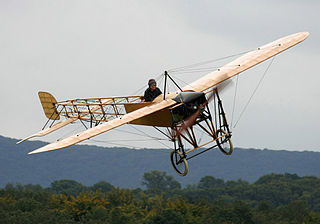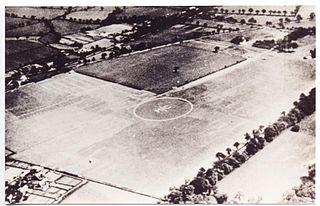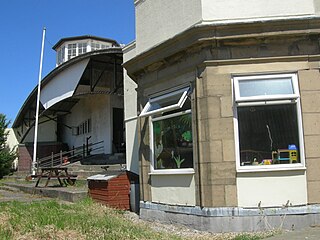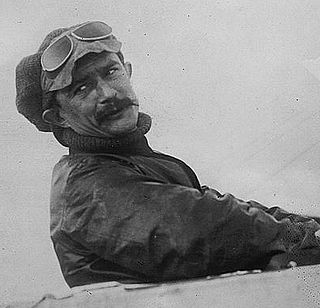Related Research Articles

Those Magnificent Men in their Flying Machines; Or, How I Flew from London to Paris in 25 Hours and 11 Minutes is a 1965 period epic comedy film featuring an international ensemble cast including Stuart Whitman, Sarah Miles, Robert Morley, Terry-Thomas, James Fox, Red Skelton, Benny Hill, Jean-Pierre Cassel, Gert Fröbe and Alberto Sordi. The film, revolving around the craze of early aviation, was directed and co-written by Ken Annakin, with a musical score by Ron Goodwin.

Captain Sir John William Alcock was a British Royal Navy and later Royal Air Force officer who, with navigator Lieutenant Arthur Whitten Brown, piloted the first non-stop transatlantic flight from St. John's, Newfoundland to Clifden, Ireland. He died in a flying accident in France in 1919.

Gustav Wilhelm Hamel was a pioneer British aviator. He was prominent in the early history of aviation in Britain, and in particular that of Hendon airfield, where Claude Graham-White was energetically developing and promoting flying.

Royal Air Force Hooton Park or more simply RAF Hooton Park, on the Wirral Peninsula, Cheshire, is a former Royal Air Force station originally built for the Royal Flying Corps in 1917 as a training aerodrome for pilots in the First World War. During the early/mid-1930s, it was one of the two airfields handling scheduled services for the Merseyside region. Hooton Park was home to No. 610 Squadron and, post Second World War, to No. 611 and No. 663 (AOP) Squadron.

City Airport is an airport in Barton-upon-Irwell, Greater Manchester, England, 5 nautical miles west of Manchester. Formerly known as Barton Aerodrome and City Airport Manchester, It is known by the Civil Aviation Authority (CAA) as Manchester/Barton.

Hendon Aerodrome was an aerodrome in London, England, that was an important centre for aviation from 1908 to 1968.
Royal Air Force Ringway or more simply RAF Ringway is a former Royal Air Force satellite station in Ringway, Cheshire, England, near Manchester. It was operational from 1939 until 1957. The site of the station is now occupied by Manchester Airport.
Castle Bromwich Aerodrome was an early airfield, situated to the north of Castle Bromwich in the West Midlands of England. The site now falls within the City of Birmingham.

The Blériot XI is a French aircraft of the pioneer era of aviation. The first example was used by Louis Blériot to make the first flight across the English Channel in a heavier-than-air aircraft, on 25 July 1909. This is one of the most famous accomplishments of the pioneer era of aviation, and not only won Blériot a lasting place in history but also assured the future of his aircraft manufacturing business. The event caused a major reappraisal of the importance of aviation; the English newspaper The Daily Express led its story of the flight with the headline "Britain is no longer an Island".

Claude Grahame-White was an English pioneer of aviation, and the first to make a night flight, during the Daily Mail-sponsored 1910 London to Manchester air race.
The Lancashire Aero Club is the oldest established flying club in the United Kingdom, it was founded in 1909 to organise the Blackpool Aviation Week, Britain's first officially recognised air show.

Alexandra Park Aerodrome was the second purpose-built aerodrome in the Manchester area in England. The site was chosen by the War Department in 1917 because of its open agricultural nature, and lay between the neighbouring districts of Fallowfield, Chorlton-cum-Hardy, Whalley Range, Withington and West Didsbury, at the junction of Princess Road and Mauldeth Road West, three miles south of Manchester's city centre: the land was owned by the Egerton Estate. The aerodrome's brief existence is commemorated on a plaque in the sports pavilion at Hough End Playing Fields, which now occupy part of the site. A commemorative plaque was unveiled on 7 July 2007 to mark the 90th anniversary of the aerodrome and is located in the grounds of No. 184 Squadron, Air Cadets, in Hough End Crescent.

Ferdinand Marie Léon Delagrange was a sculptor and pioneering French aviator, ranked as one of the top aviators in the world.

Manchester (Wythenshawe) Aerodrome was the first airfield built to serve Manchester, England.

Louis Arbon Strange, was an English aviator, who served in both World War I and World War II.

Stanley Park Aerodrome was an airfield located in the Stanley Park area of Blackpool, Lancashire, England. It was also known as Blackpool Municipal Airport, and was in use for civil and military flying from 1929 until closure of the airfield in 1947. The site is now used by Blackpool Zoo.

The 1910 London to Manchester air race took place between two aviators, each of whom attempted to win a heavier-than-air powered flight challenge between London and Manchester. The race had first been proposed by the Daily Mail newspaper in 1906. The £10,000 prize was won in April 1910 by Frenchman Louis Paulhan.

The origins of Manchester Airport in England, UK, date back to the 1930s. Construction started on Ringway on 28 November 1935 and it opened partly in June 1937 and completely on 25 June 1938, in Ringway parish north of Wilmslow, from which it derived its original name Manchester (Ringway) Airport. Its north border was Yewtree Lane. Its southeast border was a little northwest of Altrincham Road (Styal).

Jules Charles Toussaint Védrines was an early French aviator, notable for being the first pilot to fly at more than 100 mph and for winning the Gordon Bennett Trophy race in 1912.
Martin Hearn Ltd. was a British aviation company which during World War II played a major role in the assembly of thousands of American and Canadian aircraft imported to Liverpool by shipping convoys.
References
Notes
Bibliography
- Scholefield, R.A. (2004), Manchester's Early Airfields, Lancashire & Cheshire Antiquarian Society, Moving Manchester, ISSN 0950-4699
- Hearn, Peter (1994), Flying Rebel - Story of Louis Strange, HMSO, ISBN 0-11-290500-5
- History of British Aviation R. Dallas Brett